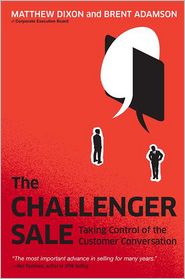If I could have written a book, The Challenger Sale would have been it. The Challenger Sale has hit on the very sales approaches, coaching, ideas and tenants I have embraced or espoused for most of my career. Not surprising, they do it in a much more elegant and descriptive way. It’s a great book.
Rather than wait till I’m finished reading to review it as traditionally do, I’m going to post excerpts here as I come across them. Why wait?
The Challenger Sale is the result of extensive research by the Sales Executive Council. They set out to measure the behaviors of top performers. What they found was sales people fall into 5 categories or profiles:
- Relationship Builders focus on developing strong personal and professional relationships and advocates across the customer organization. They are generous with their time, strive to meet customers’ every need, and work hard to resolve tensions in the commercial relationship.
- Hard Workers show up early, stay late, and always go the extra mile. They’ll make more calls in an hour and conduct more visits in a week than just about anyone else on the team.
- Lone Wolves are the deeply self-confident, the rule-breaking cowboys of the sales force who do things their way or not at all.
- Reactive Problem Solvers are, from the customers’ standpoint, highly reliable and detail-oriented. They focus on post-sales follow-up, ensuring that service issues related to implementation and execution are addressed quickly and thoroughly.
- Challengers use their deep understanding of their customers’ business to push their thinking and take control of the sales conversation. They’re not afraid to share even potentially controversial views and are assertive — with both their customers and bosses.
What the research also found was, although top performers could be found in all the categories, the Challenger profile produced overwhelming more top producers than any of the other profiles.
These findings don’t surprise me at all. For years we have been told our job is to help our customers solve problems or create opportunities for them. Our ability to solve problems or find opportunities is severely hampered if we are unable to challenge our customers and prospects. Challenging allows us to uncover unidentified opportunities, or hidden problems. Challenging gets us beyond the surface issues. It gets us to the meat of the problem.
I talked about this the other day. The best sales people are critical of their customers. Being critical, requires challenging.
I’m excited to get through the book. As I come across excerpts I love, I’m going to post them here. It will be fun to read what you think.

